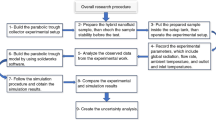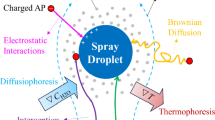Abstract
The two-stage electrostatic precipitator is widely used to purify oil mist particles. However, there is limited research on the influences of relative humidity, particle deposition characteristics, and the generation of gaseous pollutants. Therefore, this paper established a numerical model of the electrostatic oil mist purifier and applied it to a two-stage electrostatic precipitator. Then the model was used to investigate the corona discharge characteristics under different relative humidity conditions in the charged zone, the particle deposition characteristics, the purification efficiency, the ozone concentration distribution, and the oil vapor concentration distribution in the collection zone. The results indicate that, with a constant temperature, the corona current decreases as relative humidity increase, and there is a quadratic relationship between relative humidity and current. The variation in relative humidity has little impact on the purification efficiency. The maximum ozone concentration occurs near the electrode line, and its concentration is influenced by the discharge current and inlet airflow velocity. The oil vapor concentration reaches its maximum value at the side plates, with a value of 19 ppb, while it reaches the minimum value at the collecting zone electrode plate, with a value of 2 ppb. The temperature is the main factor affecting the volatilization of the oil film, with higher temperatures resulting in higher oil vapor.
Similar content being viewed by others
References
Bukowski JA (2003). Review of respiratory morbidity from occupational exposure to oil mists. Applied Occupational and Environmental Hygiene, 18: 828–837.
Chen Y, Lin CH, Lung SCC, et al. (2019). Environmental concentration of spray paint particulate matters causes pulmonary dysfunction in human normal bronchial epithelial BEAS-2B cell. Process Safety and Environmental Protection, 126: 250–258.
Farnoosh N, Adamiak K, Castle GSP (2010). 3-D numerical analysis of EHD turbulent flow and mono-disperse charged particle transport and collection in a wire-plate ESP. Journal of Electrostatics, 68: 513–522.
Feng Z, Long Z, Adamiak K (2018). Numerical simulation of electrohydrodynamic flow and vortex analysis in electrostatic precipitators. IEEE Transactions on Dielectrics and Electrical Insulation, 25: 404–412.
Gao H, Long Z, Feng Z, et al. (2022). Numerical simulation of the characteristics of oil mist particles deposition in electrostatic precipitator. Process Safety and Environmental Protection, 164: 335–344.
Gao Y, Gu Y, Tian E, et al. (2023). A two-stage cascaded ionizer for boosting PM charging in electrostatic filtration: Principles, design, and long-term performance. Separation and Purification Technology, 313: 123494.
Jaworek A, Sobczyk AT, Krupa A, et al. (2021). Hybrid electrostatic filtration system for fly ash particles emission control. Journal of Electrostatics, 114: 103628.
Kim SH, Lee KW (1999). Experimental study of electrostatic precipitator performance and comparison with existing theoretical prediction models. Journal of Electrostatics, 48: 3–25.
Li S, Zhang S, Pan W, et al. (2019). Experimental and theoretical study of the collection efficiency of the two-stage electrostatic precipitator. Powder Technology, 356: 1–10.
Mo J, Tian E, Pan J (2020). New electrostatic precipitator with dielectric coatings to efficiently and safely remove sub-micro particles in the building environment. Sustainable Cities and Society, 55: 102063.
Murakami T, Niemi K, Gans T, et al. (2013). Chemical kinetics and reactive species in atmospheric pressure helium-oxygen plasmas with humid-air impurities. Plasma Sources Science and Technology, 22: 015003.
Nouri H, Zouzou N, Dascalescu L, et al. (2016). Investigation of relative humidity effect on the particles velocity and collection efficiency of laboratory scale electrostatic precipitator. Process Safety and Environmental Protection, 104: 225–232.
Sagot B, Forthomme A, Ali Yahia LA, et al. (2017). Experimental study of cyclone performance for blow-by gas cleaning applications. Journal of Aerosol Science, 110: 53–69.
Sakiyama Y, Graves DB, Chang HW, et al. (2012). Plasma chemistry model of surface microdischarge in humid air and dynamics of reactive neutral species. Journal of Physics D: Applied Physics, 45: 425201.
Shen H, Yu W, Jia H, et al. (2018). Electrohydrodynamic flows in electrostatic precipitator of five shaped collecting electrodes. Journal of Electrostatics, 95: 61–70.
Skalny JD, Orszagh J, Mason NJ, et al. (2008). Mass spectrometric study of negative ions extracted from point to plane negative corona discharge in ambient air at atmospheric pressure. International Journal of Mass Spectrometry, 272: 12–21.
Tian E, Gao Y, Mo J (2023). Experimental studies on electrostatic-force strengthened particulate matter filtration for built environments: progress and perspectives. Building and Environment, 228: 109782.
Wang L, Chen S, Wang F (2019). Kinetic modelling of atmospheric pressure corona discharges in humid air. Plasma Chemistry and Plasma Processing, 39: 1291–1315.
Wang X, Zhou Y, Wang F, et al. (2021). Exposure levels of oil mist particles under different ventilation strategies in industrial workshops. Building and Environment, 206: 108264.
Xu M, Tan Z (2014). Calculation of townsend second ionization coefficient for photoemission at different humidities. IEEE Transactions on Dielectrics and Electrical Insulation, 21: 1764–1767.
Yue Y, Sun J, Gunter KL, et al. (2004). Character and behavior of mist generated by application of cutting fluid to a rotating cylindrical workpiece, part 1: model development. Journal of Manufacturing Science and Engineering, 126: 417–425.
Zhang Y, Xu Y (2003). Characteristics and correlations of VOC emissions from building materials. International Journal of Heat and Mass Transfer, 46: 4877–4883.
Zhang J, Shao Y, Long Z (2016). Physicochemical characterization of oily particles emitted from different machining processes. Journal of Aerosol Science, 96: 1–13.
Zhang C, Yang L (2018). One-dimensional simulation of synergistic desulfurization and denitrification processes for electrostatic precipitators based on a fluid-chemical reaction hybrid model. Energies, 11: 3249.
Zhang S, Pan W, Zhang H, et al. (2020). High-efficient removal of airborne oil mist in a wire-plate electrostatic precipitator. Journal of Electrostatics, 108: 103516.
Zhu Y, Chen C, Shi J, et al. (2020). A novel simulation method for predicting ozone generation in corona discharge region. Chemical Engineering Science, 227: 115910.
Acknowledgements
This work was supported by the National Nature Science Foundation of China (No. 51878442).
Author information
Authors and Affiliations
Contributions
All authors contributed to the study conception and design. Material preparation, data collection and analysis were performed by Wenjia Hao, Yu Guo, Yukun Wang and Tao Yu. The first draft of the manuscript was written by Wenjia Hao, Zhengwei Long, and all authors commented on previous versions of the manuscript. Hao Gao provided help in part on the influence of relative humidity on purification efficiency. All authors read and approved the final manuscript.
Corresponding author
Ethics declarations
The authors have no competing interests to declare that are relevant to the content of this article.
Rights and permissions
About this article
Cite this article
Hao, W., Guo, Y., Wang, Y. et al. Study of the multi-physics field-coupled model of the two-stage electrostatic precipitator. Build. Simul. 17, 387–398 (2024). https://doi.org/10.1007/s12273-023-1077-2
Received:
Revised:
Accepted:
Published:
Issue Date:
DOI: https://doi.org/10.1007/s12273-023-1077-2




